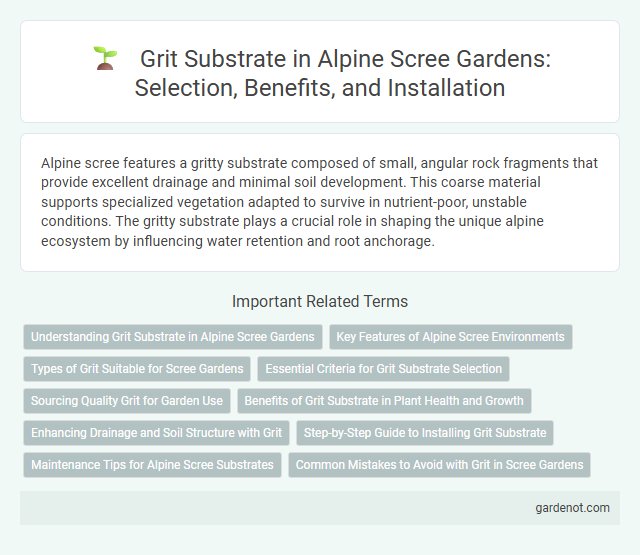Alpine scree features a gritty substrate composed of small, angular rock fragments that provide excellent drainage and minimal soil development. This coarse material supports specialized vegetation adapted to survive in nutrient-poor, unstable conditions. The gritty substrate plays a crucial role in shaping the unique alpine ecosystem by influencing water retention and root anchorage.
Understanding Grit Substrate in Alpine Scree Gardens
Grit substrate in alpine scree gardens provides essential drainage and mimics natural mountain habitats, promoting healthy root systems for alpine plants. Its coarse texture prevents waterlogging and supports moisture retention without causing rot, crucial for species adapted to rocky, well-drained soils. Selecting the right grit particle size enhances aeration and stability, ensuring robust growth in challenging alpine conditions.
Key Features of Alpine Scree Environments
Alpine scree environments are characterized by loose, angular grit substrate composed predominantly of fragmented rock debris, which facilitates high drainage and minimal nutrient retention. These substrates provide a challenging habitat due to extreme temperature fluctuations, mechanical instability, and low organic matter content. The dynamic nature of grit in alpine scree promotes specialized plant and microbial adaptations essential for survival in these harsh mountain ecosystems.
Types of Grit Suitable for Scree Gardens
Grit substrates used in alpine scree gardens include coarse sand, fine gravel, and crushed rock, each providing excellent drainage and preventing water retention that can harm root systems. Siliceous grit, rich in quartz, offers durability and resistance to weathering, making it ideal for long-term soil stability in scree environments. Limestone grit, with its alkaline properties, benefits calcicolous alpine plants by maintaining pH balance and enhancing nutrient availability.
Essential Criteria for Grit Substrate Selection
Essential criteria for grit substrate selection in alpine scree environments include particle size distribution, mineral composition, and drainage capacity. Optimal grit substrates feature angular, coarse particles that provide stability and prevent soil erosion while facilitating aeration and water permeability. High silica content and resistance to weathering are critical for maintaining substrate durability under harsh alpine conditions.
Sourcing Quality Grit for Garden Use
Sourcing quality grit for garden use in alpine scree environments ensures optimal drainage and prevents soil compaction, essential for thriving alpine plants. High-grade grit, typically composed of crushed granite or quartz, must be free from salts and clay to maintain soil pH and avoid root damage. Selecting appropriately sized grit particles enhances aeration and mimics natural scree conditions, promoting healthy root development and plant resilience.
Benefits of Grit Substrate in Plant Health and Growth
Grit substrate enhances Alpine scree plant health by improving soil drainage and aeration, preventing root rot and promoting robust root systems. Its coarse texture facilitates nutrient retention and supports microbial activity essential for nutrient cycling. The mineral composition of grit provides essential trace elements, boosting plant growth and stress resilience in harsh alpine environments.
Enhancing Drainage and Soil Structure with Grit
Grit substrate significantly improves drainage in alpine scree environments by facilitating rapid water percolation and preventing waterlogging around plant roots. Its coarse texture enhances soil aeration, promoting healthier root development and microbial activity essential for nutrient cycling. Incorporating grit into soil structure stabilizes the substrate, reducing erosion and creating optimal conditions for alpine vegetation growth.
Step-by-Step Guide to Installing Grit Substrate
To install a grit substrate in Alpine scree, begin by selecting angular, coarse gravel particles ranging from 2 to 8 millimeters to ensure proper drainage and stability for alpine plants. Evenly spread a 5 to 10-centimeter layer over a well-prepared base of compacted soil or gravel to mimic natural mountainous conditions. Regularly monitor moisture retention and adjust the substrate depth to prevent root rot and support resilient plant growth.
Maintenance Tips for Alpine Scree Substrates
Regular inspection and removal of debris from grit substrates in alpine scree environments prevent soil compaction and promote proper drainage. Periodic replenishment of angular grit particles supports stability and mimics natural erosion processes essential for alpine plant health. Ensuring adequate water runoff through substrate leveling reduces moisture retention that can lead to root rot in scree-specific flora.
Common Mistakes to Avoid with Grit in Scree Gardens
Using inappropriate particle size or inconsistent grit can disrupt drainage and root stability in scree gardens, leading to plant stress or failure. Avoid compacted or overly fine grit that retains moisture, as this encourages root rot and fungal diseases in alpine plants. Properly graded, well-draining, and inert grit substrates improve aeration and mimic natural scree conditions for optimal plant health.
Grit substrate Infographic

 gardenot.com
gardenot.com